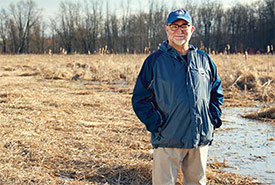Nature at work

Douglas Hevenor at Minesing Wetlands, ON (Photo by Mike Ford)
From flood mitigation, to health, food security and water quality, nature is providing solutions to many of our challenges, including climate change and biodiversity loss
By Alanna Mitchell, Canadian science journalist
Standing here in southern Ontario’s Minesing Wetlands on a brisk spring morning, Douglas Hevenor is thinking about the legacy he’s helping create for his grandchildren.
He savours a line of silver maples, so imposing they seem to stand guard over the sparkling ponds of water in the marsh. Off in the distance, past a skeletal ring of cattails, there’s a surprising slash of crimson where redosier dogwood branches reach for the sky. The odd gray dogwood shows up, too, and white cedar, tamarack, willow and a few sycamores.
Over there, a muskrat pokes its head out of the Mad River to check us out before going back about its business. A pair of red-winged blackbirds swoop overhead, and Canada geese, the loudest birds in the neighbourhood, are having trouble keeping in key. “This is land that wants to be wetland,” Hevenor tells me, pointing across the marsh, which stretches far past where our eyes can see.
The Minesing Wetlands is one of the oldest of the Nature Conservancy of Canada’s (NCC’s) projects, which cover a total of 14 million hectares (35 million acres). Across the nation, the organization and its partners are in league with nature to find solutions for the planet’s problems. At one time, this part of the marsh was tilled for crops, explains Hevenor, chief administrative officer of the Nottawasaga Valley Conservation Authority, which, along with NCC, Ducks Unlimited Canada, the province and the local Simcoe county, own nearly 6,000 hectares (nearly 15,000 acres) of this sprawling wetland (the other 5,000 hectares/12,355 acres are privately owned).
Today, nearly 50 years after its conservation began, Minesing is considered one of the most important wetlands in the world. In fact, it’s so critical to the watery workings of the planet that it merits designation as a Ramsar Wetland of International Importance, an honour given to fewer than 2,500 wetlands internationally. But while the marsh, a short drive west of Barrie, has become a cherished spot for visitors, it is far more than just a wilderness jewel. Now that it’s back to being marshland, it acts as a giant set of kidneys for the area, and as a natural sponge.
That means it filters sediments and contaminants, such as heavy metals and agricultural fertilizers, out of the water as it passes through. It also stores water, cutting the volume by as much as half during peak flood season, says Brittany Hope, a conservation biologist with NCC, who loves to canoe in Minesing’s swamp forest when the water is high. In essence, she says, the marsh is vast enough to spread out the water’s flow and slow it down.
Hevenor says that means the communities downstream from Minesing, including Wasaga Beach, where he lives, are protected from catastrophic floods, now, and for years to come. “You manage it for the next generation,” he says, as he strides through the swamp in his rubber boots.
This is an excerpt of a story that first appeared in the summer 2021 issue of the Nature Conservancy of Canada Magazine. Donors who contribute at least $25 or more per year will receive the magazine. Click here to donate today and start receiving the magazine.
Explore additional content from our summer issue here >



